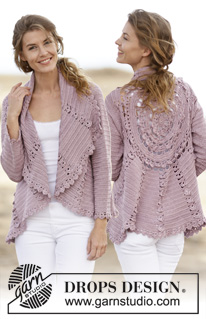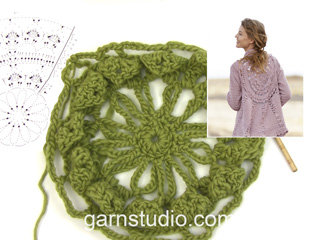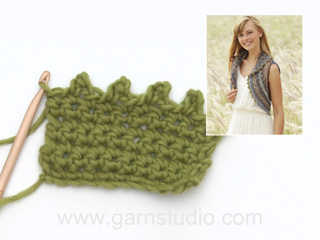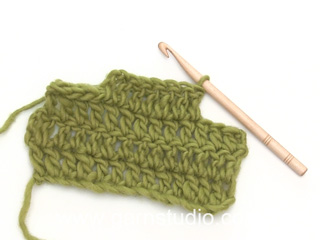Ros |
||||||||||||||||||||||||||||||||||||||||
 |
 |
|||||||||||||||||||||||||||||||||||||||
Crochet DROPS jacket worked in a circle with lace pattern in ”Cotton Viscose”. Size: S - XXXL.
DROPS 162-11 |
||||||||||||||||||||||||||||||||||||||||
|
PICOT: Work 2 ch, 1 dc in the 2nd ch from hook. CROCHET INFO: Beg every tr round/row with 3 ch that replace first tr and finish every round/row with 1 sl st in 3rd ch from beg of round/row. PATTERN: See diagrams A.1-A.2. After 3rd round, repeat A.1 6 times in total on round. CROCHET 3 TR TOG: Work 3 tr into 1 tr at beg of row as follows: Work 3 ch (= replace 1 tr), work 1 tr, but wait with last pull through (= 2 strands on hook), then work next tr but on last pull through, pull yarn through all sts on hook. DECREASE TIP (applies to sleeves): Dec at beg of row by working 1 sl st over the tr to be dec. Dec at end of row by working until 1 tr to be dec remains, turn piece. ---------------------------------------------------------- CIRCLE: Work 7 ch on hook size 3.5 mm with Cotton Viscose and form a ring with 1 sl st in first ch. Then work A.1 as follows: ROUND 1: Work 3 ch, 12 tr in ch-ring, finish with 1 sl st in 3rd ch from beg of round. ROUND 2: Work 1 ch, * 1 dc in first tr, 14 ch *, repeat from *-* 12 times in total, finish with 1 sl st in first dc. Fasten off. ROUND 3: Work 1 sl st in first ch-space, 5 ch, * 1 sl st in next ch-space, 5 ch *, repeat from *-* 11 times in total, finish with 1 sl st in first ch-space. A.1 is repeated 6 times in total on round. ROUND 4: Work 3 ch, in first ch-space work: * 2 tr, 3 ch, 2 tr in same ch-space, 1 ch *, repeat from *-* 12 times in total, finish with 1 sl st in 3rd ch from beg of round. ROUND 5: Work 1 ch, in first ch-space work 2 tr, 2 dtr, 1 PICOT – see explanation above, 2 dtr, 2 tr, 1 dc in next ch, * in next ch-space work 2 tr, 2 dtr, 1 picot, 2 dtr, 2 tr, 1 dc in next ch *, repeat from *-* 11 times in total, finish with 1 sl st in first ch = 12 leaves. ROUND 6: Work 1 ch, * 6 ch, 1 dc in dc and ch (from 5th and 4th round) *, repeat from *-* 12 times in total, finish with 1 sl st in first ch. ROUND 7: Work 4 ch, * 3 ch, 1 tr in next ch-space, 7 ch, 1 tr in next ch-space, 3 ch, 1 tr in same ch-space, 4 ch *, repeat from *-* 6 times in total, finish with 1 sl st in 4th ch. ROUND 8: Work 3 ch, 3 tr in next ch-space, * 1 tr in next tr, 7 tr in next ch-space, 1 tr in next tr, 1 tr in next ch-space, 3 ch, 1 tr in same ch-space, 1 tr in next tr, 7 tr in next ch-space *, repeat from *-* 5 times in total, 1 tr in next tr, 7 tr in next ch-space, 1 tr in next tr, 1 tr in next ch-space, 3 ch, 1 tr in same ch-space, 1 tr in next tr, 4 tr in first ch-space, finish with 1 sl st in 3rd ch = 114 tr. REMEMBER THE CROCHET TENSION! ROUND 9: Work 3 ch, * 1 tr in every tr until ch-space, in ch-space as follows: 1 tr, 3 ch, 1 tr *, repeat from *-* the entire round, finish with 1 sl st in 3rd ch = 126 tr. ROUND 10: Work 1 ch, * 7 ch, skip 6 tr, 1 sl st in next tr, 7 ch, skip 6 tr, 1 sl st in next tr, 5 ch, 1 sl st in next tr, 7 ch, skip 6 tr, 1 sl st in next tr *, repeat from *-* 5 times in total, 7 ch, skip 6 tr, 1 sl st in next tr, 7 ch, skip 6 tr, 1 sl st in next tr, 5 ch, 1 sl st in next tr, 7 ch, skip 6 tr, 1 sl st in first ch. ROUND 11: Work 3 ch, in every ch-space work 2 tr, 3 ch, 2 tr, 1 ch, finish with 1 sl st in 3rd ch. ROUND 12: Work 1 ch, * in next ch-space work 2 tr, 2 dtr, 1 picot, 2 dtr, 2 tr, 1 dc in next ch *, repeat from *-* 24 times in total, finish with 1 sl st in first ch = 24 leaves. ROUND 13: Work 1 ch, * 6 ch, 1 dc in dc and ch (from 12th and 11th round) *, repeat from *-* 24 times in total, finish with 1 sl st in first ch. ROUND 14: Work 4 ch, * 3 ch, 1 tr in next ch-space, 7 ch, 1 tr in next ch-space, 3 ch, 1 tr in same ch-space, 4 ch *, repeat from *-* 12 times in total, finish with 1 sl st in 4th ch. ROUND 15: Work 3 ch - READ CROCHET INFO, work 4 tr in first ch-space (i.e. ch-space with 3 ch), now work tr in all ch-space with 7 ch from previous round, do not work in ch-space with 3 ch from previous round. Work * 8 tr in each of the next 7 ch-spaces, 9 tr in next ch-space *, repeat from *-* 2 times in total, 8 tr in each of the next 7 ch-spaces, 5 tr in last ch-space (i.e. ch-space with 4 ch) = 195 tr. ROUND 16: Work * 1 tr in each of the first 14 tr, 2 tr in next tr *, repeat from *-* 13 times in total = 208 tr. ROUND 17: Work * 2 tr in first tr, 1 tr in each of the next 15 tr *, repeat from *-* 13 times in total AT THE SAME TIME inc 1 tr extra on round = 222 tr. ROUND 18: Work 1 ch, * 6 ch, skip 5 tr, 1 sl st in next tr *, repeat from *-* 37 times in total, finish with 1 sl st in first ch. ROUND 19:Work as round 11 in A.1: Work 3 ch, in every ch-space work 2 tr, 3 ch, 2 tr, 1 ch, finish with 1 sl st in 3rd ch. ROUND 20: Work as round 12 in A.1: Work 1 ch, * in next ch-space work 2 tr, 2 dtr, 1 picot, 2 dtr, 2 tr, 1 ch *, repeat from *-* 37 times in total, finish with 1 sl st in first ch = 37 leaves. ROUND 21: Work as round 13 in A.1: Work 1 ch, * 6 ch, 1 dc in dc and ch (from 20th and 19th round) *, repeat from *-* 37 times in total, finish with 1 sl st in first ch. ROUND 22: Work as round 14 in A.1: Work 4 ch, * 3 ch, 1 tr in next ch-space, 7 ch, 1 tr in next ch-space, 3 ch, 1 tr in same ch-space, 4 ch *, repeat from *-* 18 times in total, work 3 ch, 1 tr in last ch-space, 4 ch, finish with 1 sl st in 4th ch. ROUND 23: Work 4 tr in first ch-space (i.e. ch-space with 3 ch), now work tr in all ch-space with 7 ch from previous round, do not work in ch-space with 3 ch from previous round. Work * 7 tr in next ch-space, 8 tr in next ch-space, 7 tr in next ch-space *, repeat from *-* 11 times in total, 8 tr in next ch-space, 8 tr in next ch-space, 7 tr in next ch-space, 4 tr in last ch-space (i.e. ch-space with 4 ch) = 273 tr. Then work piece back and forth. Work every row tog at the end of row with 1 sl st in 3rd ch from beg of row. Turn piece. ROW 24 (= WS): Work * 2 tr in next tr, 1 tr in each of the next 11 tr (= tr-group), A.2 *, repeat from *-* 13 times in total = 169 tr and 13 A.2. Turn piece. A.2 is repeated vertically until finished measurements. ROW 25 (= RS): Work A.2, 2 tr in first tr, 1 tr in each of the next tr in tr-group, * A.2, 2 tr in first tr in tr-group, 1 tr in each of the next tr *, repeat from *-* until 1 tr-group remains, 2 tr in first tr, 1 tr in each of the next tr = 182 tr. Turn piece. ROW 26: Work as row 24 = 195 tr (15 tr between every A.2). ROW 27: Work as row 25 = 208 tr (16 tr between every A.2). Repeat row 24-27 0-1-1 more time = 208-260-260 tr (= 16-20-20 tr between every A.2). Piece measures approx. 20-23-23 cm from centre and outwards. Now work arm holes as follows: ROW 28 (= from WS): Work 2 tr in first tr, 1 tr in each of the next 15-19-19 tr, A.2 as before, 2 tr in next tr, 1 tr in each of the next 15-19-19 tr, A.2, 54-62-62 loose ch (= right armhole), skip: 16-20-20 tr + A.2 + 16-20-20 tr + A.2, work * 2 tr in next tr, 1 tr in each of the next 15-19-19 tr, A.2 *, repeat from *-* 5 times in total, 2 tr in first tr, 1 tr in each of the next 15-19-19 tr, 54-62-62 loose ch (= left armhole), skip: A.2 + 16-20-20 tr + A.2 + 16-20-20 tr, work A.2, 2 tr in next tr, 1 tr in each of the next 15-19-19 tr, A.2 = 153-189-189 tr, 9 A.2 and 108-124-124 ch. ROW 29 (from RS): Work A.2, 2 tr in next tr, 1 tr in each of the next 16-20-20 tr, A.2, in ch-row (= left armhole) work as follows: 1 tr in each of the 54-62-62 ch, * 2 tr in next tr, 1 tr in each of the next 16-20-20 tr, A.2 *, repeat from *-* 5 times in total, 2 tr in next tr, 1 tr in each of the next 16-20-20 tr, in next ch-row (= right armhole) work as follows: 1 tr in each of the 54-62-62 ch, then work A.2, 2 tr in next tr, 1 tr in each of the next 16-20-20 tr, A.2, 2 tr in next tr, 1 tr in each of the next 16-20-20 tr = 270-322-322 tr and 9 A.2. ROW 30 (= from WS): Work 1 tr in each of the next 18-22-22 tr, A.2 as before, 1 tr in each of the next 18-22-22 tr, A.2, 1 tr in each of the next 18-22-22 tr, A.2 (adjust row according to the other repetitions), 1 tr in each of the next 18-22-22 tr, A.2, * 1 tr in each of the next 18-22-22 tr, A.2 *, repeat from *-* 5 times in total, 1 tr in each of the next 18-22-22 tr, A.2, 1 tr in each of the next 18-22-22 tr, A.2, 1 tr in each of the next 18-22-22 tr, A.2, 1 1 tr in each of the next 18-22-22 tr, A.2 = 234-286-286 tr and 13 A.2. Work pattern as before but now inc only on every row from RS until 52-52-60 rows have been worked in total = 377-429-481 tr (29-33-37 tr in every tr-group). Insert 4 markers in the piece as follows from WS: Work 29-33-37 tr, A.2, 14-16-18 tr, insert 1st marker, work 15-17-19 tr, * A.2, 29-33-37 tr *, repeat from *-* 4 times in total, insert 2nd marker here (1st-2nd marker = right front piece). Work A.2, 29-33-37 tr, A.2, 29-33-37 tr and A.2, insert 3rd marker here. * Work 29-33-37 tr, A.2 *, repeat from *-* 4 times in total, 15-17-19 tr, insert 4th marker. (3rd-4th marker = left front piece), 14-16-18 tr, A.2. Tr between 1st and 4th marker are up towards neck. Fasten off. RIGHT FRONT PIECE: Now work right front piece between 1st and 2nd marker, beg from 2nd marker (i.e. from RS) = 131-149-167 tr and 4 A.2. Continue inc in tr-groups as before BUT do not inc in tr-groups in each side of front piece - AT THE SAME TIME dec 2 tr at beg of every row by CROCHET 3 TR TOG - see explanation above. Work until 10-12-12 cm over front piece have been worked, adjust to finish with 1 whole repetition of A.2. Fasten off. LEFT FRONT PIECE: Work left front piece between 3rd and 4th marker the same way as right front piece, beg from 4th marker (i.e. from RS). EDGE: Work an edge around the entire jacket as follows: Work the first 2 rounds of A.2, when working first round of A.2 over tr-rows, skip 2 tr-rows on each side of tr-group. Beg every round with 3 ch and finish with 1 sl st in 3rd ch. SLEEVES: Work back and forth from armhole and down, work every row tog with 1 sl st at the end of row. Insert 1 marker in piece, NOW MEASURE PIECE FROM HERE. Beg by working 86-94-102 tr evenly around the opening for sleeve, beg of row should be under sleeve. Then work 3 rows with 1 tr in every tr. Continue with 1 tr in every tr - AT THE SAME TIME dec differently in the different sizes as follows: READ DECREASE TIP! SIZE S/M: Dec 1 st in each side of piece alternately every 3rd and 2nd row 16 times in total = 54 tr. SIZE L/XL: Dec 1 st in each side of piece every other row 20 times in total = 54 tr. SIZE XXL/XXXL: Dec 1 st in each side of piece every other row 24 times = 54 tr. ALL SIZES: Work 1 tr in every tr until sleeve measures approx. 47 cm, adjust so that next row is from WS. Then work the first 2 rounds of A.2 (= 6 repetitions in width). Fasten off. Work the other sleeve the same way. |
||||||||||||||||||||||||||||||||||||||||
Diagram explanations |
||||||||||||||||||||||||||||||||||||||||
|
||||||||||||||||||||||||||||||||||||||||

|
||||||||||||||||||||||||||||||||||||||||

|
||||||||||||||||||||||||||||||||||||||||

|
||||||||||||||||||||||||||||||||||||||||
|
Have you made this or any other of our designs? Tag your pictures in social media with #dropsdesign so we can see them! Do you need help with this pattern?You'll find tutorial videos, a Comments/Questions area and more by visiting the pattern on garnstudio.com. © 1982-2024 DROPS Design A/S. We reserve all rights. This document, including all its sub-sections, has copyrights. Read more about what you can do with our patterns at the bottom of each pattern on our site. |
||||||||||||||||||||||||||||||||||||||||

























































Comments / Questions (263)
Ik wil graag het vest drop 161-11 maken maar twijfel over de maat ik draag maat 44 dus veelal xl maar kan niet wijs uit de maten om te kiezen welke maat ik miet maken
29.02.2024 - 09:58DROPS Design answered:
Dag Jolanda,
Het handigst is om een bestaand kledingstuk erbij te pakken dat je goed zit en de maten hiervan te vergelijken met de maten in de maattekening onderaan het patroon. Op deze manier kun je wellicht de maat vinden die bij je past.
01.03.2024 - 07:31Terminé los 2 frentes con una repeticion completa de A2, es decir, con la fila de varetas. Sigue la orilla y tengo que tejer las 2 primeras filas de A2. Las partes que serian el cuello y el borde inferior quedaron con la primera fila de A2, es decir, con el grupo de 4 varetas en un mismo punto. Esta correscto? Donde inicio las orillas?
20.05.2023 - 02:25DROPS Design answered:
Hola Maria Angela, para trabajar la orilla tienes que haber acabado la labor con la fila de varetas, no puedes haber terminado unas partes en otra fila de A.2. Revisa que el cuello y el borde inferior estén correctos. La orilla se trabaja según la primera fila de A.2, que se trabaja sobre las varetas,
21.05.2023 - 20:04Muchas gracias por su explicación anterior, me permitió continuar el proyecto. Tengo dudas con la orilla, debo trabajar las primeras 2 vtas de A.2, y cuando se está trabajando la primera vta de A.2 que seria el grupo de pa, tengo que saltar 2 hileras de p.a. de cada lado del grupo de p.a. Cuales son estas hileras?
03.05.2023 - 23:58DROPS Design answered:
Hola Verónica, es para el ajuste de puntos del borde. Recuerda que el borde no se trabaja sobre puntos específicamente, si no que sobre extremos de filas. Por eso, saltamos 2 filas en el delantero (que sería equivalente a saltar 4 puntos) a cada lado del grupo de p.a. para que el borde no quede demasiado abierto.
07.05.2023 - 13:20FRENTE DERECHO\r\ntengo dudas en la elaboracion drl proyecto a partir del Frente derecho, tengo que seguir tejiendo toda la vuelta incluido el frente izquierdo o se tejen por separado? Cusles son los grupos que debo seguir aumentando y en cuales no debo aumentar?
28.04.2023 - 00:51DROPS Design answered:
Hola Verónica, los delanteros se trabajan por separado; primero uno y luego el otro. No se aumenta en el 1º y último grupo de puntos altos en cada delantero.
30.04.2023 - 22:18Hola. Estoy confundido con el borde. Se hace de forma repetida el A.2 sin hacer los puntos altos entre cada A.2?
09.04.2023 - 06:20DROPS Design answered:
Hola Luis, sí, se trabaja A.2 de forma repetida.
10.04.2023 - 17:26Buenos días! Me refiero a la primero fila de cada delantero. Entre cada dibujo de A2 ¿Cuántos puntos hay? Un saludo y muchas gracias María
07.11.2022 - 10:13DROPS Design answered:
Hola María, como puedes ver en la hilera 24, entre cada A.2 se trabajan 2 puntos altos en 1 punto y 1 punto alto en cada uno de los siguientes 11 puntos altos. Por lo tanto, deberías tener 13 puntos entre cada A.2. A.2 es una repetición de 9 puntos.
20.11.2022 - 23:03Buenos días! Estoy haciendo este precioso modelo y me encontré con una dificultad al hacer los delanteros. Me podría explicar cómo se distribuyen los puntos entre los A2? Un saludo y muchas gracias
25.10.2022 - 09:04DROPS Design answered:
Hola María, puedes concretar tu pregunta? Qué fila de A.2 te da dificultades? La distribución de los puntos en cada fila se encuentra indicada en las explicaciones del patrón.
06.11.2022 - 23:49Never mind. Total brain fart here. 😉
23.07.2022 - 16:41I’m kinda new to big crochet projects. So this is probably a poor question. Row 27 is 20 dc between A2s. No problem. That makes 21 dc for Row 28. Row 28 says 19 dc then A2. It doesn’t says to decrease 2 dc or skip 2 dc. So, it makes the A2 in the wrong place by 2 dc. What happens to the 2 dc that are left over in the row if I start and A2 at after 19 dc and not 21dc?\r\nI’m so confused. I’ve gotten this far be ripping out rows 10 + times. The yarn is getting thin!
20.07.2022 - 00:41DROPS Design answered:
Dear Mrs Hansen, in the 2nd and 3rd size, you should end with 20 dc between each A.2, so that you will work 19 dc before/after each increase on row 28 (= 1 increase, 19 dc or 19 dc, 1 increase). Happy crocheting!
01.08.2022 - 10:50Bonjour, je suis au rang 23 mais je arrive pas à avoir 273B. Je me retrouve avec 279 pourtant j’ai suivi à la lettre, calculer maintes et maintes fois mais rien n’y fait. Pouvez vous m’aider svp?\r\nMerci
03.07.2022 - 15:44DROPS Design answered:
Bonjour Sandra, vérifiez qu'à la fin du tour 22 vous avez bien 36 arceaux + 2 arceaux de 3 ml (1 au début + 1 à la fin du tour), vous aurez ainsi: 4 b + (7b+8b+7b) x 11 (=33arceaux) + 8b+8b+7b (+3arceaux) + 4 b = 1 arceau de 3 ml + 36 arceaux + 1 arceau de 3 ml = 4+ (242) + 23+4=273b. Bon crochet!
04.07.2022 - 08:50